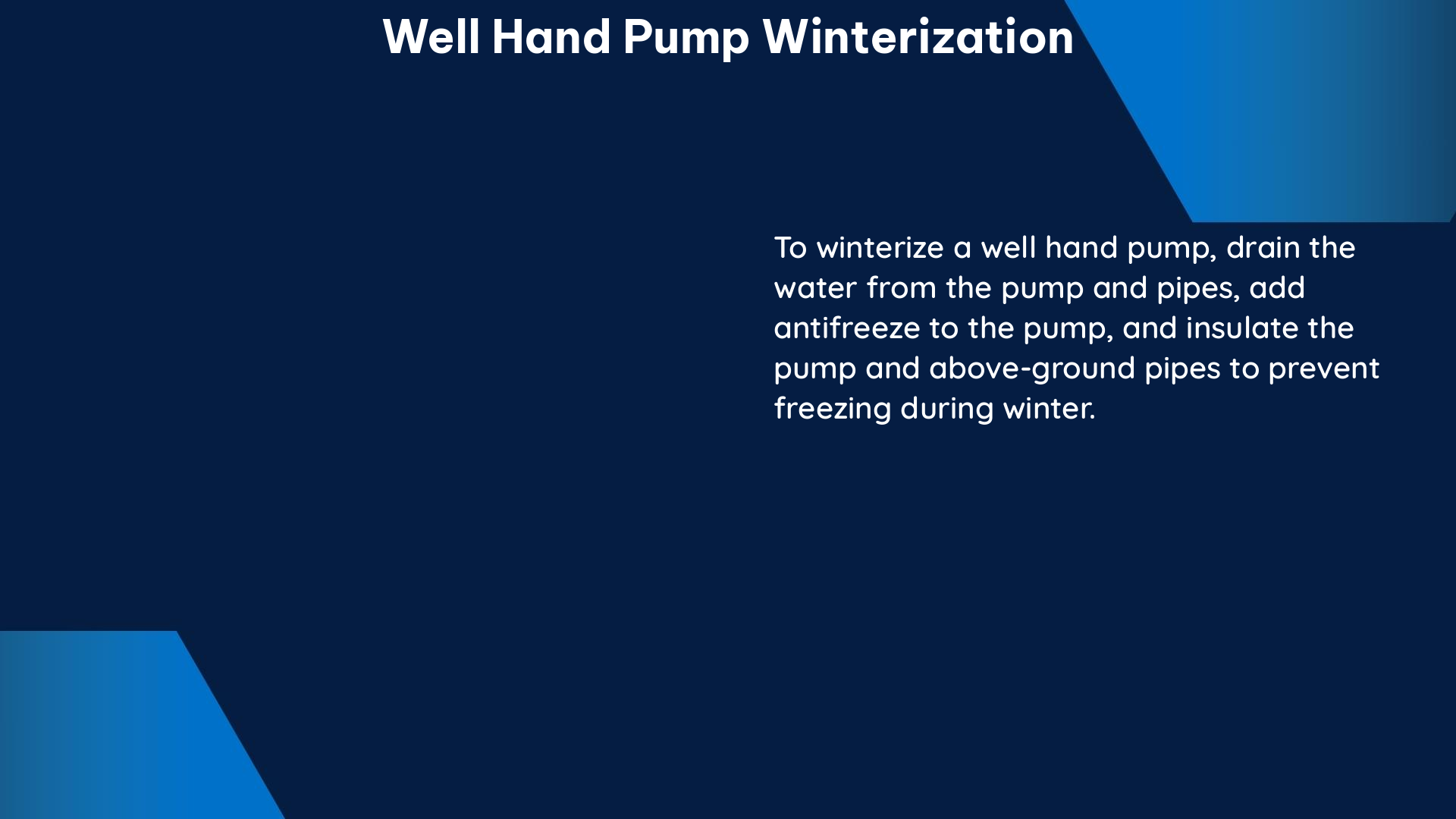Winterizing a well hand pump is a crucial task for those living in colder climates to prevent freezing and damage to the pump. This comprehensive guide will provide you with detailed, technical information on the key data points and steps to ensure your well hand pump is properly winterized.
Temperature Threshold
The freezing point of water is 32°F (0°C). To prevent freezing, the temperature of the water in the pump and pipes should be kept at least 5°F (2.8°C) above this threshold, ideally between 37°F (2.8°C) and 40°F (4.4°C). This can be achieved through the use of insulation and supplemental heating sources.
Vertical Lift

The vertical lift of a well hand pump is the measurement from the pumping or dynamic water level within the well to the outlet of the well. For surface water systems, it is measured from the ground elevation of the surface pump to the elevation of the intake. This vertical lift should not exceed 25 feet (7.6 m) for shallow well hand pumps used in winter conditions. Exceeding this limit can make it difficult to generate enough suction to draw water from the well.
Elevation Head
The elevation head is the difference in elevation between the water source (well) and the outlet (e.g., storage tank or stock tank). This difference must be accounted for to ensure that the pump is able to deliver the required water demand, especially in systems with remote storage. For every 2.31 feet (0.7 m) of elevation change, there is a corresponding 1 psi (6.9 kPa) of pressure change that the pump must overcome.
Friction Loss
Friction losses apply only to the piping and appurtenances between the point of intake (i.e., the well) and the point of discharge (i.e., the storage tank or stock tank). These losses should be accounted for in the Total Dynamic Head (TDH) calculation to ensure that the pump is sized correctly. Typical friction loss values for well hand pump systems range from 0.5 to 5 psi (3.4 to 34.5 kPa) per 100 feet (30.5 m) of pipe.
Solar Insolation Value
For solar-powered well hand pump systems, the average solar insolation value for the month with the least solar intensity should be used to calculate the design system flow rate to be delivered by the pump. This value is crucial in ensuring the system can meet the daily water requirements, even during the least favorable solar conditions.
Daily Water Requirement
The daily water requirement should be calculated based on the needs of the operation, such as livestock watering, household use, or agricultural irrigation. This value is used to determine the design system flow rate that the pump must be able to deliver.
Hand Pump Lift
The lift of the hand pump should be considered when choosing a hand pump for winter use. A lift of 25 feet (7.6 m) is often required for shallow well hand pumps used in winter conditions to ensure sufficient suction and water flow.
Winterization Steps
- Drain the Pump: Disconnect the pipe that leads to the pump and let it drain completely to remove any remaining water.
- Disconnect the Pump: Disconnect the pump from the power source (if applicable) and store it in a dry, protected area.
- Insulate the Pump: Insulate the pump and pipes with high-quality insulation material, such as closed-cell foam or fiberglass, to prevent freezing.
- Use a Heating Source: Install a heating source, such as a heat lamp or heat tape, to keep the pump and pipes above the freezing point. Ensure the heating source is properly sized and installed to maintain the desired temperature range.
- Check the Pump Regularly: Regularly check the pump and surrounding area throughout the winter to ensure the heating source is functioning properly and there are no signs of freezing.
By following these detailed steps and considering the key data points, you can ensure your well hand pump is properly winterized and protected from the harsh winter conditions.
References
- Winterizing Hand Pump or Water Pump
- Winterizing a Shallow Well Hand Pump
- Shallow Well Hand Pump Over Winter
- Winterizing a Hand Pump
- Solar-Powered Water Pump Systems for Stockwater Design

The lambdageeks.com Core SME Team is a group of experienced subject matter experts from diverse scientific and technical fields including Physics, Chemistry, Technology,Electronics & Electrical Engineering, Automotive, Mechanical Engineering. Our team collaborates to create high-quality, well-researched articles on a wide range of science and technology topics for the lambdageeks.com website.
All Our Senior SME are having more than 7 Years of experience in the respective fields . They are either Working Industry Professionals or assocaited With different Universities. Refer Our Authors Page to get to know About our Core SMEs.